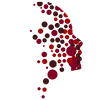In this practice, the OptiDerm is typically only used during the post-operative recovery period. Following adequate wound healing, the SLP staff will transition you to one of the regular adhesive housing varieties.
Because the OptiDerm is typically used in the presence of surgical wounds, the material of this housing, as well as the application, is different from the standard adhesives.
Because the OptiDerm is typically used in the presence of surgical wounds, the material of this housing, as well as the application, is different from the standard adhesives.
Step 1: Preparing the skin around the stoma
The skin and wounds around the stoma should be thoroughly cleaned. Be sure to remove any dirt or debris in the area. This includes any dry mucous or blood crusting. Be sure the skin is dry before moving to the next step.
Step 2: Heating the Adhesive
This should be done before removing the backing!
In the hospital, heating the adhesive can be accomplished by placing it between your warm hands or against your torso. This should be warmed for several minutes to ensure the best adhesion. At home, using a blow drier on the low/warm setting can be very effective in heating the adhesive. It should be soft and flexible before removing the backing.
Step 3: Applying the OptiDerm Housing
During this step, it is important you do not handle the sticky surfaces of the housing after the backing is removed. The central ring is an ideal place to hold the housing, and there is a tab on every housing that is also free from adhesive. Using these points, you will be able to handle the housing without disrupting the adhesive backing.
While you are able to clearly see your stoma, apply the housing to the skin around the stoma, first pressing the ring to the skin, then working the adhesive outward from the middle. This adhesive is safe to place directly over surgical wounds. Once placed, gently apply pressure over to the surface of the OptimDerm, including the wound areas, to ensure adequate adhesion.
* It is important you DO NOT center the ring around the stoma, with the stoma squarely in the middle. INSTEAD, you want to try to align the bottom of the stoma, with the bottom of the ring. This is not critical, but the larger the gap between the bottom of the stoma and the ring, the more you will collect secretions in the gap. This pooling will break down the seal more quickly than if there was proper alignment.
While you are able to clearly see your stoma, apply the housing to the skin around the stoma, first pressing the ring to the skin, then working the adhesive outward from the middle. This adhesive is safe to place directly over surgical wounds. Once placed, gently apply pressure over to the surface of the OptimDerm, including the wound areas, to ensure adequate adhesion.
* It is important you DO NOT center the ring around the stoma, with the stoma squarely in the middle. INSTEAD, you want to try to align the bottom of the stoma, with the bottom of the ring. This is not critical, but the larger the gap between the bottom of the stoma and the ring, the more you will collect secretions in the gap. This pooling will break down the seal more quickly than if there was proper alignment.

